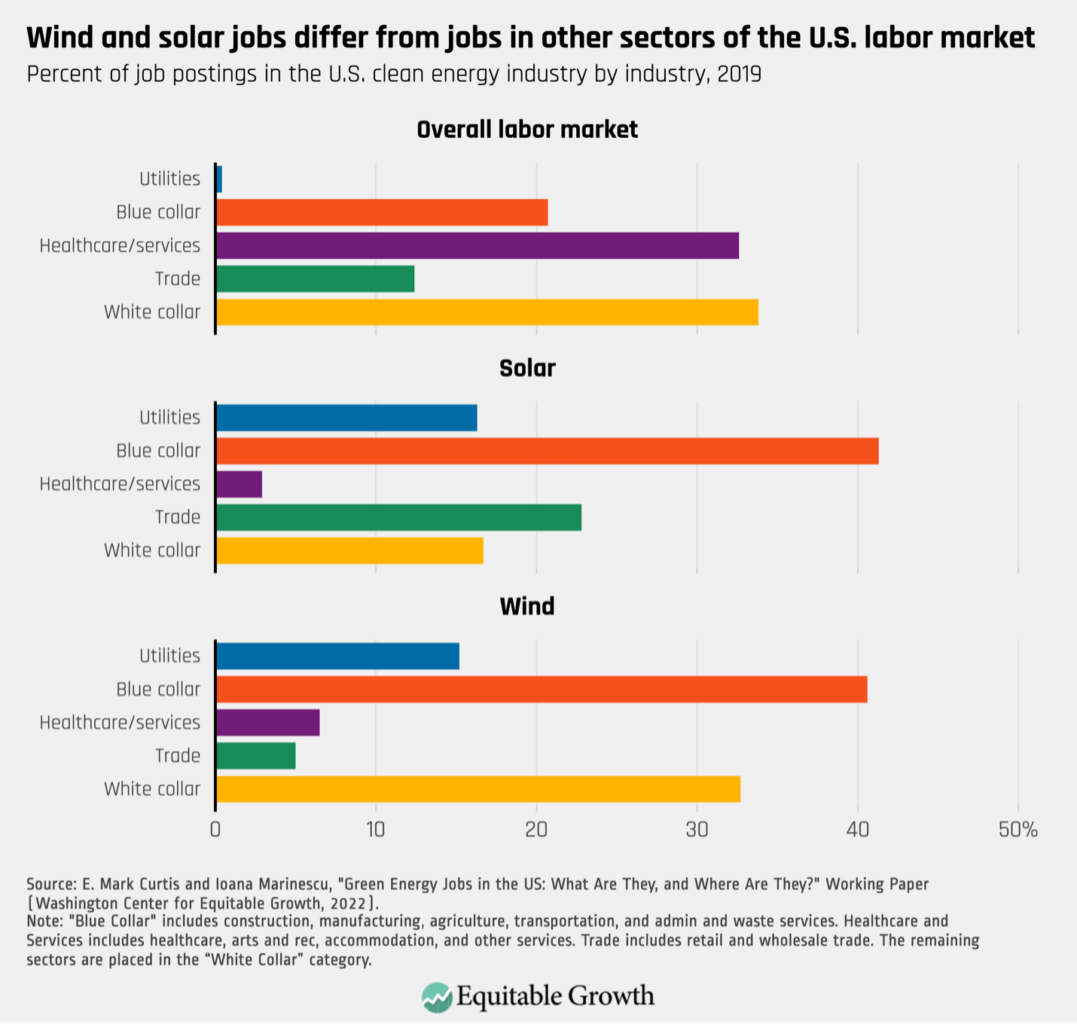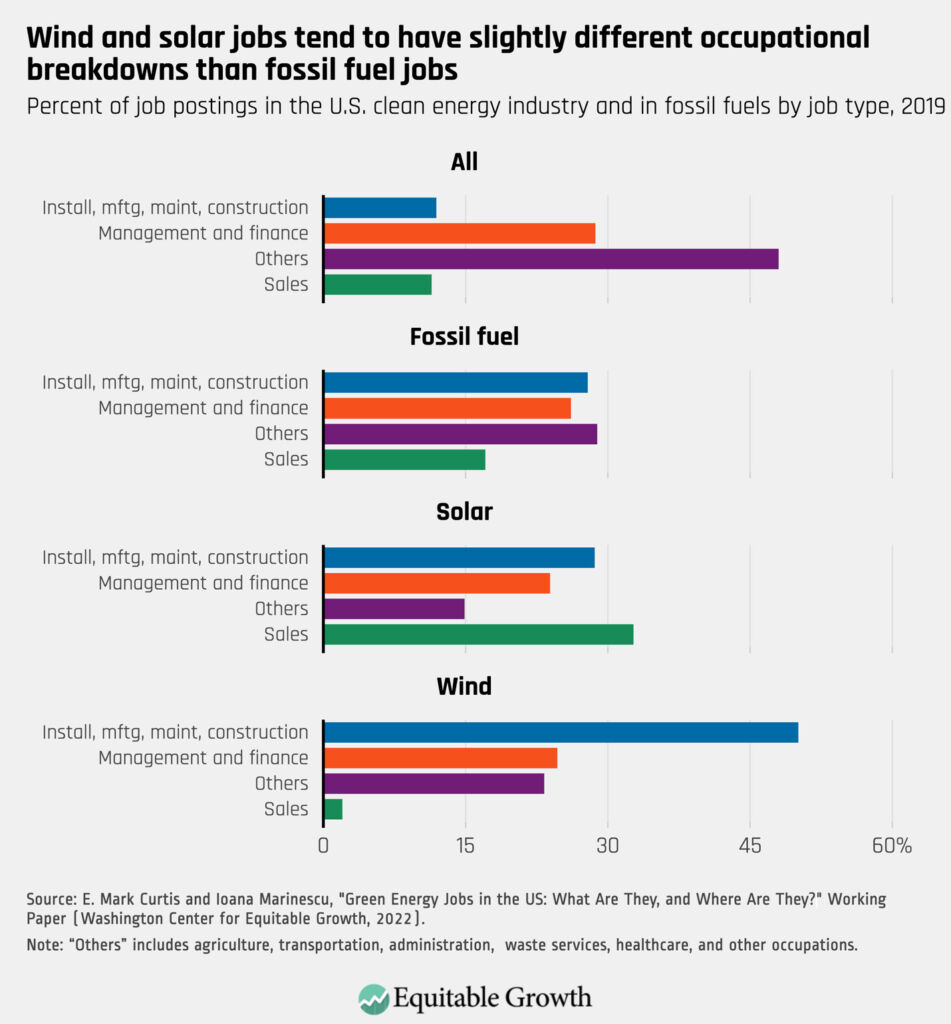Green jobs are good for U.S. workers and the U.S. economy

Earlier this year, the U.S. Congress passed and President Joe Biden signed into law one of the most consequential climate bills in U.S. history. The Inflation Reduction Act allocates $369 billion to clean energy and electric vehicle tax breaks, domestic manufacturing of batteries and solar panels, and pollution-reduction efforts.
In addition to mitigating the effects of climate change and driving consumption of renewable energy, these investments will add jobs in the clean energy sector—some estimates say as many as 912,000 per year over the next decade. As employment in the fossil fuel industry dwindles amid changes in U.S. energy markets, new research suggests that the growth in renewable energy benefits U.S. workers and is particularly good for workers who live in areas with high rates of employment in fossil-fuel extraction industries.
The paper, co-authored by E. Mark Curtis of Wake Forest University and Ioana Marinescu of the University of Pennsylvania, develops a measure of green jobs—specifically, occupations in the solar and wind energy fields. Using data from Burning Glass Technologies, a labor market analytics firm, on job postings in the United States, the authors find that green jobs saw incredibly strong growth in recent years—a trend that they find is, overall, quite beneficial for workers.
Indeed, jobs in the solar energy industry increased approximately five-fold since 2013, with more than 52,000 postings in 2019 alone. That same year, there were about 13,500 wind job openings—triple the number before 2013. By way of comparison, the number of new fossil-fuel jobs in 2019 was around 44,000. (See Figure 1.)
Figure 1

To be sure, these findings are based on job postings for open positions and do not necessarily reflect filled positions or work actually being done. Nevertheless, this trajectory closely follows the growth in solar and wind electricity production in the United States in the same time period, thougH interestingly wind electricity makes up a larger share of energy production than solar—despite there being more solar jobs than wind jobs. The authors posit that this discrepancy may be a result of different technologies in the two sectors, including the larger number of workers needed in the solar industry than the wind industry to produce the same amount of electricity.
Curtis and Marinescu also find that green jobs tend to be in occupations that are about 21 percent higher-paying than the average in other industries—including fossil-fuel extraction—with the pay premium being even greater for green jobs with low educational requirements. They also find that green jobs in general have the same educational requirements as other jobs, with about 40 percent requiring only a high school degree.
About one-third of solar jobs are in sales occupations, while about 37 percent of wind jobs entail installation, manufacturing, maintenance, and construction. Around a quarter of all jobs in both wind and solar are in management and finance occupations, while close to 30 percent of fossil fuel jobs are listed as “other,” which includes anything from agriculture, waste services, transportation, administration, and other services. (See Figures 2 and 3.)
Figure 2

Figure 3

In general, in terms of occupational classification, green jobs are more similar to fossil-fuel jobs than to all other jobs in the U.S. labor market—yet, as the authors find, green jobs tend to be specifically in occupations that pay more. This suggests that the coming renewable energy boom will create high-paying job opportunities for many U.S. workers, and especially for low-skilled workers.
Curtis and Marinescu also find that green jobs, while unevenly distributed across the country, tend to be located in communities with a high share of employment in the oil and gas industry, such as Texas and across the Midwest. They propose that this correlation could be due to geographic conditions that favor both renewables and fossil fuels—for instance, they write, more wind in the mountains where coal is extracted. (See Figure 4.)
Figure 4

The co-authors also find that solar jobs tend to be located in commuting zones with higher non-White populations, while the opposite is true for wind jobs. They hypothesize this could have to do with where solar and wind jobs are mostly located and the demographic makeups of these areas. In other words, as Figure 4 displays, many solar jobs are in the southern half of the United States, from California through Florida, where there is a bigger non-White population, whereas wind jobs are largely in the Midwest, where fewer non-White people tend to live.
The fact that green jobs and fossil-fuel jobs tend to be located in the same areas, along with the occupational similarities and job requirements in the two industries, suggest that many job losses in oil and gas that result from a renewable energy boom may be offset by an influx of clean energy jobs. The transition from a carbon-intensive economy to a green economy therefore may be smoother than previously predicted.
Indeed, this study presents a new angle to the debate over the move to a low-carbon economy. While most previous work has focused on jobs and wages lost from moving away from fossil fuels, Curtis and Marinescu instead highlight the benefits of this new, cleaner economy. It is likely that these results, as well as those from similar research on green jobs, will be helpful in guiding policymakers as they work to allocate funding from the Inflation Reduction Act and spur a renewable energy labor boom.







